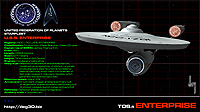AH, that's just more TNG techno-babble to me, LOL.
Na, I love TNG, just not as much as TOS. I do have that book though, I just never read it all, like I read all my TOS stuff. And that's not an all that bad of a concept, I guess. I just like mine better eh.
The only reason I think the way I do is because I base my idea of bussards on the real Bussard Ramjet ram-scoop configuration.
To be honest, TNG science extrapolation and techno-babble did tend to wear a wee-bit thin for me, both science-wise, and let's fill out the hour out explaining 24th century crap, ut, it's them darn EPS conduits again surprise surprise over and over and over again, by writers that I felt, were not always qualified to be writing real science-fiction, which I consider more along the lines of real thought-out work ala Asimov, Clarke, Heinlein, Niven (who used the concept a lot), Baxter, etc.
deg
Actually, it's kinda funny... But the article you linked to describes the process that I was talking about above. At least this is how I understood the Bussard collectors (or Bussard ramscoop as I've seen them listed in other Trek literature). This is actually pretty close to (and probably exactly) what's in the TNG Tech Manual.
This is from the article to which you linked.
The mass of the ion ram scoop must be minimized on an interstellar ramjet. The size of the scoop is large enough that the scoop cannot be solid. This is best accomplished by using an electromagnetic field, or alternatively using an electrostatic field to build the ion ram scoop. Such an ion scoop will use electromagnetic funnels, or electrostatic fields to collect ionized hydrogen gas from space for use as propellant by ramjet propulsion systems (since much of the hydrogen is not ionized, some versions of a scoop propose ionizing the hydrogen, perhaps with a laser, ahead of the ship.) An electric field can electrostatically attract the positive ions, and thus draw them inside a ramjet engine. The electromagnetic funnel would bend the ions into helical spirals around the magnetic field lines to scoop up the ions via the starship's motion through space. Ionized particles moving in spirals produce an energy loss, and hence drag; the scoop must be designed to both minimize the circular motion of the particles and simultaneously maximize the collection. Likewise, if the hydrogen is heated during collection, thermal radiation will represent an energy loss, and hence also drag; so an effective scoop must collect and compress the hydrogen without significant heating. A magnetohydrodynamic generator drawing power from the exhaust could power the scoop.


 ), that is the idea of a "scoop" I was thinking in terms of, which is actually way way way beyond the size of Trek bussards. Plus, being a MOPAR gear-head, I naturally tend to think of the idea of "scoop" (ala hood-scoop) along the lines of the three like-shaped boxes just below the domes.
), that is the idea of a "scoop" I was thinking in terms of, which is actually way way way beyond the size of Trek bussards. Plus, being a MOPAR gear-head, I naturally tend to think of the idea of "scoop" (ala hood-scoop) along the lines of the three like-shaped boxes just below the domes.


